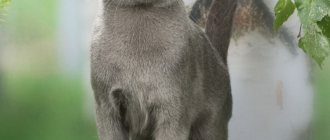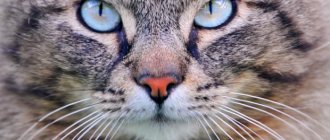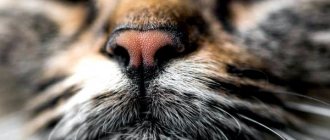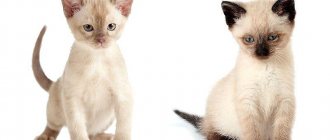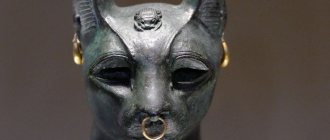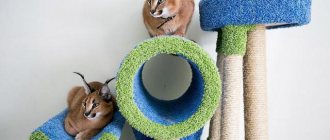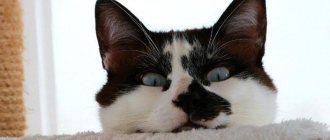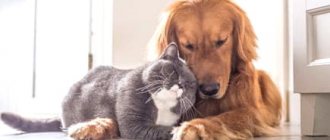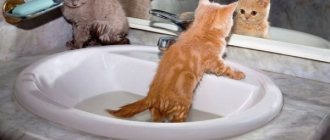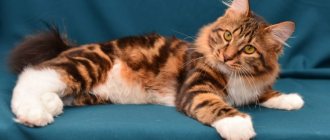Cats appeared long before the appearance of the first civilizations. And they have been living side by side with humans for thousands of years. Cats were first depicted by the ancient Egyptians around 1950 BC. What Egyptian cat breed has survived to this day?
Cats were important to the ancient Egyptians. They tamed them and took care of them more than themselves. Despite Egypt's huge role in the domestication of cats, there are not many breeds left that have their roots in this desert country. Let's take a closer look at six breeds that can be traced back to Egypt.
Egyptian Mau
By the name it is easy to understand where this cat breed came from. We can say that the Egyptian Mau is the most Egyptian of all modern cat breeds. These spotted animals bear a striking resemblance to those depicted in ancient Egypt. And this breed was worshiped many centuries ago.
The breed was almost exterminated during the Second World War. The Russian princess saved the Egyptian Mau breed. This is the only domestic cat that has been spotted naturally. They are the fastest of all domestic cats, reaching speeds of up to 50 km per hour.
Features of choosing a nickname
When choosing an Egyptian nickname for your furry pet, it is advisable to adhere to the following recommendations:
- You should not give your cat any name that is associated with Egypt just because you like the sound of it. The fact is that each Egyptian nickname has a certain meaning, and also carries very powerful energy, so you need to be sure to familiarize yourself with the meaning of the chosen word.
- Egyptian names for cats and tomcats are very different. It is necessary to clearly find out which nicknames are considered male and which are considered female, so as not to make a mistake in the choice.
- It is advisable that the pet's name contain hissing sounds. This will allow the cat to remember its name faster.
- When giving preference to one nickname or another, you need to remember that it will be impossible to rename the cat once it has become accustomed to its name.
Shirazi - Egyptian cat breed
In Egypt, you can see many Shirazi cats roaming the streets. If you believe the myths and ancient legends, then this breed of cats was formed when Egypt was part of the Persian Empire. The breed is not registered, but in their homeland they are common.
Shirazi is a cross between the Egyptian Mau and the Persian. They have the same colors and markings as the Egyptian Mau. They are calmer than Mau. They combine the best features of both parent breeds.
Character
Any cat breed has certain personality traits; many of them in Egyptian sphinxes can be explained by appearance features:
- The hairless cat loves human warmth and affection.
- This breed of cat gets along well with other animals (even large dogs).
- The Sphynx is an intelligent animal; it easily remembers the location of its toilet and scratching post.
- This cat is extremely rarely capricious; she always behaves with restraint and politeness.
- Sphinxes easily endure long roads and visiting trips.
- The breed of such cats is decorative; the hunting instinct is almost completely absent.
- The animal is good with children and can play with them for hours. There are no pronounced pain points on the body of a hairless cat: if the baby squeezes the cat hard enough, it will not hurt.
- Sphinxes strive to attract attention to themselves: at home they do not part with their owner and “help” him with household chores; his authority is very valuable for the cat. Loneliness is quite difficult for pets.
- It is difficult to tolerate any disease.
- By their nature, animals are quite vulnerable; you should not shout at them.
Abyssinian
Although it is not proven that Abyssinians originated in ancient Egypt, they are very similar to the African wild cat. Their closest ancestors originated in the Nile Valley, but the Abessinian breed was created in Great Britain. These cats were brought from Abyssinia - modern Ethiopia, after a military expedition.
During World War II, this cat breed almost disappeared. After World War II the breed was repopulated, and feline leukemia almost wiped them out again. Abessinians look like small pumas due to their ticked fur. Although Abyssinians are prone to a number of health problems, they can live for more than 15 years.
Maneki-neko
In Japan, the famous image of Maneki-neko - a figurine of a cat with one raised paw spiritualizes the goddess of mercy. According to one legend, the emperor passed by a temple, next to which a cat was sitting. Suddenly the animal raised one paw, calling the emperor to come closer. Attracted by the animal's gesture, the emperor entered the temple, and a moment later realized that lightning had struck the place where he had recently stood. So the animal saved the emperor’s life. Since then, it is generally accepted that a cat brings good luck. Figurines of these animals with a raised paw were installed in temples; at one time only noble persons could own figurines. Today, the Maneki-neko figurine is a popular gift in Japan, protecting the home and bringing good luck.
Nile cat
There is some controversy surrounding the Nile cat. This is essentially a wild cat breed discovered in Egypt. Some consider them to be Egyptian Mau, although the International Cat Association has recognized them as a separate experimental breed. These are street cats that no one takes care of in Egypt.
An American rescue group is relocating these cats to America. This breed can be identified by the mantle on its back and sides, which is distinct from the rest of its body. These cats come in a variety of colors and patterns, with long and short hair.
Chinese myths
The Chinese goddess Li Shuo was depicted as a cat. According to ancient Chinese myth, at the beginning of the creation of the world, the gods appointed cats to monitor the progress of their creation. Animals were given the ability to speak. However, they were more interested in sleeping under the cherries and playing with falling petals, rather than worldly concerns. Three times the gods came down to earth to check how well the animals were doing their job, and all three times they were disappointed with the animals. Then the gods assigned the duties of cats to people and deprived the animals of the ability to speak. Now animals were entrusted with one task - maintaining order in the world and preserving time. To this day, the Chinese believe that by looking into the eyes of a cat you can determine the time of day.
Chausie
This breed was created by crossing the Nile cat with domestic breeds. Chausie cats have been found in several ancient Egyptian temples, indicating that the Egyptians valued them even before they were bred into the Chausie we know today.
This is one of the largest breeds of domestic cats, sometimes weighing up to 11 kg. This is one of the few cat breeds that love water. In 2013, the International Cat Association finally registered the breed.
Secrets of cat energy
Many people go to Egypt not only for a wonderful holiday, but also for miracles. Everyone secretly hopes that in this country there are some mystical elements that will help get rid of problems, and a person will be able to realize his desires. For example, earn a lot of money, get married, make a career leap and even lose weight. Some Egyptian drawings, figurines, talismans and amulets really have miraculous powers. But do not forget that Egyptian cat figurines are funerary attributes. Placing such an object at home is equivalent to decorating an apartment with a cross brought from the cemetery.
The Egyptians installed such figurines on the graves of the dead to mark the boundary between this world and the other world. To protect against the penetration of evil spirits from a parallel world into our reality.
Savannah cat
Savannah cats are among the largest domestic cats. They can reach a weight of up to 11 kg. and are very similar to their wild cat ancestors. This breed was created by crossing a domestic cat with a wild African cat named Serval. There is no evidence that this breed originates directly from Egypt, but servals have a distinguished history in Egypt. In Ancient Egypt, servals were exotic gifts and were traded as far back as the time of Tutankhamun.
Early generations are the largest, and later generations are closer to the size of the average domestic cat. They have strong hunting instincts, so it is best not to keep them in homes with birds, fish or other small pets. Savannah cats are one of the few felines known to love water.
Egyptian names and their meanings
The names of the deities of Egypt and Greece are considered good options for nicknames for cats.
For example, a female kitten can be given a nickname:
- Amaunet is the progenitor of the Universe.
- Anat is the goddess of the hunt.
- Astarte is the patroness of love, fertility and abundance.
- Bastet is a symbol of female happiness.
- Isis is the mother of all gods, a symbol of femininity.
- Kebhut is the goddess of cool water.
- Mafdet is the patroness of the sun.
- Meskhent is the protector of babies.
- Naunet is a symbol of the night sky.
- Nephthys is the goddess of beauty.
- Nekhbet is a symbol of nobility and greatness.
- Nut is the patroness of the sky.
- Rashida is a symbol of justice.
- Sekhmet is the goddess of war.
- Sia is the goddess of wisdom.
- Taurt is the patroness of mothers and children.
- Tefnut is the goddess of power.
- Upes is the patroness of fire.
In addition, as a nickname for your cat, you can choose one of the euphonious female and popular names in Egypt that carry some meaning:
- Azenet is daddy's daughter.
- Azizi is precious.
- Aisha is peace-loving.
- Akana is a ball.
- Amizi is a flower.
- Ati is soft like a pillow.
- Banafrit is a beautiful soul.
- Bahiti – prosperity, abundance, well-being.
- Jendayi - grateful.
- Yerby is a princess.
- Evs is a cat.
- Ia is the moon.
- Ife – family well-being, love.
- Isis is the queen.
- Kanika is black.
- Kebi - honey.
- Kepi is energetic.
- Kivu is plump.
- Kiya is cheerful.
- Quibila is peaceful.
- Mandisa is sweet.
- Merit is my favorite.
- Mert – prefers silence.
- Miu is tender.
- Monifa is lucky.
- Mukarramma - respected.
- Naima is friendly.
- Nanu is a beauty.
- Nebi is a panther.
- Nkrumah is born ninth.
- Nubit is a golden lady.
- Nein is pretty.
- Odjit is evil.
- Olabisi – brings joy.
- Razia is charming, charming.
- Rashida is fair.
- Rehema - compassionate.
- Sajira is small.
- Salama – calm.
- Sanera is a kitten.
- Tabia is talented.
- Unique – radiance.
- Femi - beloved.
- Hagar - abandoned.
- Hasina is kind.
- Khepri - morning sun.
- Cheezy is a mystery.
- Shamiz – born first.
- Shani is lovely.
For a boy kitten, you can choose one of the following nicknames based on the names of various Egyptian gods and mythical creatures:
- Aikhi is the god of music.
- Aker is a protector of people from evil spirits.
- Amon is the patron of the sun.
- Apis is the god of fertility.
- Bennu is a symbol of eternal life.
- Var is a symbol of sky and light.
- Horus is the god of the rising sun.
- Montu is the god of war.
- Nun is the progenitor of all gods.
- Onuris is the god of war and hunting.
- Osiris is the god of rebirth.
- Ra is the supreme god.
- Seb is the patron of the earth and fertility.
- The scarab is a sacred beetle, a popular symbol of Egyptian culture.
- The Sphinx is a mythical creature with the body of a lion and the head of a man.
- Thoth is a symbol of wisdom.
- Phoenix is a mythical bird that rose from the ashes.
- Shu is the god of air.
- Shadu is the patron saint of travelers and wanderers.
- Yah is the god of the moon.
An Egyptian nickname for a male kitten can be chosen from the following names, but you should definitely pay attention to their meaning:
- Abasi is serious.
- Adjo is a treasure.
- Akil is smart.
- Amun - hidden.
- Badru - born on a full moon.
- Bomani is a fighter.
- Jahi – honored.
- Jumoke is everyone's favorite.
- Donkor – modest.
- Yabi is weak.
- Kenty is a leader.
- Kuaashi - born on Sunday.
- Mhotep - peace.
- Mshey is a traveler.
- Nomti – strong.
- Ozaz - beloved by God.
- Oi - glory.
- Okpara is the first born.
- Otta – third born.
- Ra is the sun.
- Rashidi - wise.
- Runichera is a destroyer.
- Seth is bright.
- Tabit is a tough guy.
- Ubaid is a devotee.
- Hadji - born during a pilgrimage.
- Shenti – fluffy.
- Yafeu – brave.
- Yahya - bestowed by heaven.
Nicknames for girls cats
Some owners prefer to call their female cats Egyptian names in honor of the queens of this ancient state:
- Aat, Arsinoe;
- Bathires, Benerib, Berenice, Betrest;
- Capes, Cleopatra;
- Merneith;
- Nebtu, Neith, Nefertari, Nefertiti, Nefrusebek, Nitocrida, Nitocris;
- Satia;
- Takhat, Tausert, Tia, Tyti;
- Hatshepsut, Khensa, Khenut, Khenkhenet;
- Eurydice.
Sacred cats in Hinduism
Animals have an important place in Hinduism. It is said that when Brahma created animals, he hid a certain secret in each of them so that people would discern spiritual significance in them. Hindus believe that the souls of ancestors can pass into animals or that ancestors can be reborn in the guise of animals. In the basic teachings of Hinduism, cats have no special significance, and there is no practice of worshiping them. However, they did not suffer persecution or violence due to various beliefs that implied a negative attitude towards them, such as in medieval Europe.
Cats are symbolized with deception and insincerity. An example is a stone bas-relief at Mahabalipuram (Tamil Nadu) depicting a statue of a cat in a meditative pose - standing on one leg and holding its front legs above its head. Several rats pray at his feet. The bas-relief is based on a story from a tantric text, which describes how a cat, posing as a pious devotee, kept the attention of mice by eating them in between tasks until they realized their folly.
At the same time, Hinduism has an ancient school of theism known as the cat school. Followers of the doctrine base their behavior on the example of a kitten allowing its mother to carry itself by the scruff of the neck. They believe that a person should trust God, who, like a mother cat, will carry them through the ocean of samsara, overcoming all obstacles.
Killing a cat is considered a grave sin, which will have to be begged and given alms. Therefore, despite attributing negative qualities to these animals, Hindus show respect for them and allow them to live in their homes.
LiveInternetLiveInternet
No less interesting is the ancient Russian mythology associated with cats. The Slavs have a legend about an underground cat with fiery ears that guards treasures and scares away wolves. This legend is especially famous among Ural gold miners. And there are so many legends, customs and beliefs that the Russian people have about cats. Some of them are not only known to this day, but also play a big role in the lives of superstitious people who live according to signs. A cat can predict the weather, protect a house from evil spirits, prophesy the arrival of guests, and unmistakably distinguish an evil person from a good one. And in fact, many signs come true. Especially if you believe in them unconditionally.Proverbs and signs:
- A black cat shows its tail from the chimney (smoke) - A white cat climbs into the window (about the dawn sun) - A cat washes itself - to guests or a change in weather. - A cat lies with its belly up - towards warmth, hides its head - towards cold, fluffs its tail - towards a snowstorm. — The cat is plagued by the ninth death (about the vitality of cats) — The tongue is as lascivious as a cat — The cat would have blurted out, but his tongue is short
Cats are known to love affection, home warmth, cleanliness and comfort. At the same time, cats are the most independent and proud animals among those tamed by humans. Cats are people who are secretive, affectionate and deceitful.
If a cat is a pronounced female image, an animal that loves the comfort of home, then a cat is a free, wandering creature, the embodiment of lust and hidden power. The learned cat Bayun (storyteller) is a frequent guest of Slavic fairy tales. His sonorous voice scares away spirits for many miles around.
Cats are attached to the house more than anything, even more than to the owner. There have been cases where a cat remained in an old, cold house when people moved to a new one. In this way, cats resemble brownies, faithful to their corner until its complete destruction.
Black cats were considered assistants to sorcerers and witches, and meeting them was a bad omen. Witches rode around on cats and goats. A hostile spirit can enter a cat’s body to escape persecution or to enter a person’s home. In this form, a witch can ride a horse or even a person to death.
A werecat was also called a cat-cat. A cat, jumping over a dead man, will certainly turn him into a vampire. Whoever kills a cat will incur seven years of troubles and misfortunes.
The eternal confrontation between the cat and the mouse reflects the struggle between two forces - earthly and underground, accumulating and creative, dark and hidden (Veles) and heavenly, furious and renewing thunderstorm power (Perun).
Cat time is winter. Colors – black, white
A cat is a domestic animal, endowed with dual symbolism and various demonic functions in folk beliefs and often paired with a dog.
The cat is assessed ambiguously: both as a clean animal and as an unclean one. They say: “The cat’s fur is dirty, but its snout is clean; The dog’s snout is dirty, but its fur is clean”; “You can kiss a dog on the face, not on the fur; a cat, vice versa.” According to Bulgarian beliefs, the cat rejoices at the death of its owner, and the dog cries; The cat adds to the owner's torment in hell by fanning the flames under his cauldron, and the dog carries water and pours on the fire. Beliefs explain the origin of the Cat both from the devil and from the glove of the Mother of God. In the legend of the Flood, the Cat saves Noah's Ark by plugging its tail into a hole that had been gnawed by a mouse created by the devil. It is forbidden to kill the Cat, otherwise there will be no luck in anything. It is believed that if a person sleeps with a Cat, his mind will become clouded. It is dangerous to carry the Cat with horses, because it makes the horse dry out. Cats are not allowed into the church. Cats and dogs should not be allowed to eat food consecrated in church. However, the Poles sometimes gave them specially blessed bread and butter at Easter. This custom is explained by the popular idea that people have bread thanks to the Cat and the Dog: according to the widespread legend about the ear of bread, because of their disrespectful attitude towards bread, people now use bread, which God left only for the share of Cats and Dogs. It is a bad omen if a Cat (any cat, not just a black one) crosses the road or meets you on the way. For hunters and fisherman, a meeting with the Cat promised failure in fishing. In this regard, they tried not to mention the Cat during the hunt or called it something else (for example, casserole).
In the guise of a black Cat, evil spirits are often represented. At the same time, the Cat is believed to be able to see evil spirits invisible to humans. A devil may appear in the form of a Cat. In cat form they represent the souls of the dead, especially those who atone for their sins after death or did not die a natural death. Death is shown to young children in the form of a Cat. The black Cat was also seen as the embodiment of diseases: cholera and “cow death”. Russians believe that black cats and dogs protect the house from lightning, but they also consider it dangerous to have them in the house during a thunderstorm. This is explained by the belief that during a thunderstorm, God tries to strike the devil with lightning, and the devil hides from God, turning into a cat, dog or other animal. Ukrainians have a well-known story about how a forester, during a thunderstorm, saw a black cat that was not affected by thunder, and shot it with a blessed tin button. After this, St. appeared to him in a dream. George said that he killed Satan, who had been teasing the saint for seven years.
The cat has the characteristics of a domestic patron. Its presence in the house has a beneficial effect on the household and livestock. They believe that a stolen Cat brings happiness to the house. And there are no cats in an unhappy house. When moving to a new house, owners often let the Cat into it first, and only then move in themselves. Entering after her, the owner goes to the corner that the brownie should choose for himself. When a Cat is brought into a new home, it is placed on the stove next to the chimney, i.e. where, according to popular beliefs, the brownie lives. There are often stories about a brownie who turns into a Cat.
The cat is used in folk magic and medicine. They believe, for example, that a black cat has a miraculous bone. If obtained, it can make a person invisible or give him the ability to know everything. Anyone who, at midnight at a crossroads, pricks his finger with such a bone and signs his name in blood, will receive into his service a devil-brownie, who will bring stolen money, grain, milk from other people’s cows, etc. into the house. In some Russian provinces, in order to prevent the beginning of the death of livestock, it was considered necessary to bury the dead cattle in the barn along with the living Cat. To protect themselves from cholera, they drew a furrow around the village with a small plow, into which they harnessed a cat, a dog and a rooster, all of them black. The swollen udder of a cow was treated by scratching it with the claws of a domestic cat. A child suffering from consumption was bathed in a font together with a black Cat, so that the disease would pass on to the Cat. For a runny nose, you should sniff the smoke of a scorched cat's tail. White cat fur was used as a remedy for burns.
According to popular belief, a cat can have a beneficial effect on sleep. Therefore, the image of a cat, like a hare, is often found in lullabies. Before placing the baby in the cradle for the first time, a cat is placed there so that the baby sleeps soundly. The idea of the relationship between the Cat and the hare is noted among the Serbs, who believe that the hare descended from the Cat. In folk culture, the cat is a symbolic analogue of the bear, and the dog is the wolf. In East Slavic fairy tales, in Russian and Lusatian tales, an evil spirit, frightened by a bear (devil, kikimora, water bear, etc.), calls it “cat”. Russian peasants have a known way of summoning a forest spirit with the help of a cat - a “boletus”, which has a bearish appearance.
How was Bastet revered?
The heyday of the Bastet cult dates from the 10th to the 8th centuries BC. At that time she was considered a national deity. Although temples dedicated to the goddess existed in various cities, the main place of worship was the city of Bubastis. It was a pilgrimage center that thousands of people sought to visit. The temple at Bubastis was surrounded by a wall richly decorated with reliefs. Inside was a huge statue of Bast. It was customary to bring small cat figurines as gifts to the goddess.
Bastet's veneration was expressed in relation to cats. For example, in memory of a deceased cat, the owner could shave his eyebrows. A driver who accidentally ran over a cat could be stoned by the crowd. The punishment for damage to an animal was determined by the importance of the cat. In addition, archaeologists have discovered thousands of cat mummies.
Almost every temple had its own “cat guard.” These priests carefully watched the temple cats so as not to miss a secret message from Bastet. Egyptian houses often kept figurines of cats, which were supposed to resist evil forces. The Egyptians also believed that after death the soul of the mistress of the house moved into a cat. Amulets with images of cats were a guarantee of fertility.
Herodotus's History included a description of the annual ancient Egyptian celebrations held in honor of Bastet. They fell on April 15th. On this day it was customary to dance and have fun. The priests loaded the statue of the goddess into a boat and solemnly transported it along the banks of the Nile. According to Herodotus, 700 thousand people flocked to the city of Bubastis during the holiday. And although the number of pilgrims is most likely exaggerated, it indicates the significance of the holiday.
Even the pharaohs were averse to making sacrifices in the temple of the goddess. It is interesting that the arrows with which the Egyptians emphasized their eyes were also an attempt to imitate Bastet. True, the love of cats once played a cruel joke on the Egyptians. This happened in 525 BC. Then the Persian king Cambyses stormed the Egyptian city of Pelusium. To weaken the resistance of the Egyptians, he placed troops of cats in front. This story is most likely anecdotal, but notes the importance of cats to the Egyptians.
